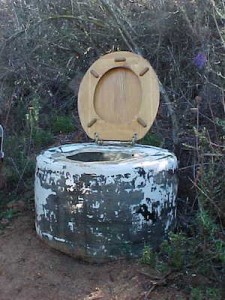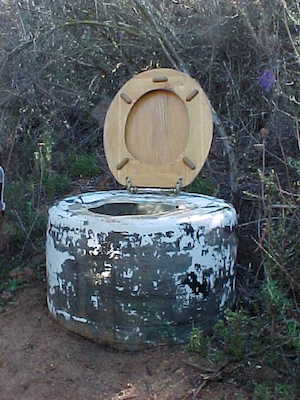
In extreme emergencies, sewage systems may not be functioning. During these times it may be necessary to create a temporary, emergency toilet for safely collecting and handling human waste until normal sewage systems can be restored.
Get started
When creating an emergency toilet, it is always important to:
- Locate the toilet away from food preparation or eating areas.
- Provide a place next to the emergency toilet to wash hands that offers soap, running water and a method to dry hands.
- Store a large supply of heavy-duty plastic bags, twist ties, disinfectant and toilet paper.
- After each use, pour a disinfectant into the container. This will help avoid infection and stop the spread of disease. Mix one part bleach to 10 parts water for an effective, easy to use disinfectant. Avoid dry bleach, as it is caustic and dangerous for this type of use.
- Keep doors and covers closed when the toilet is not in use. This promotes sanitation and, for outdoors toilets, keeps out insects and animals and prevents injury and spread of disease.
- Always supervise small children when they are using the emergency toilet.
Outdoors
If you live away from an urban area, you can dig your own emergency toilet. Just bear in mind the following:
- Locate latrines and portable toilets at least 100 feet away from surface water bodies such as lakes, rivers and streams and at least 100 feet downhill or away from any drinking water source (i.e. well or spring) home, apartment or campsite.
- The hole for a latrine must be at least three feet deep. Keep the bottom of the hole at least one foot above hardpan or the water table. Sites that cannot be dug deep enough and still provide a one-foot separation to a water table or hardpan are not appropriate sites for an outdoor toilet. Never deposit waste or garbage on open ground.
- After each use, throw dirt, lime, mulch or ash in the latrine to minimize odors and to keep flies, mosquitoes and rodents away.
- Cover the latrine between uses with plywood or another material.
Hand washing station
Use a spring water jug with holes punched in the top of the cap. Fill with water and tie a nylon knee-high containing a piece of bar soap to the handle. Sprinkle hands with water and rub soap through the nylon to generate lather. This is great as an emergency or camping wash station as the soap stays attached to the water and kills most bacteria. Water use is kept to a minimum.
Indoors
When water service is interrupted, do not use your indoor toilet. The water remaining in the fixture is not sufficient to flush the wastes down the sewer. For city dwellers, it’s in the best interest of everyone to keep emergency toilets indoors to prevent the spread of infection and disease. You can either make or buy an emergency indoor toilet.
1. Make an emergency toilet from a pail or other container:
- Line the inside of a toilet bowl, 5-gallon pail, or another appropriately sized waste container with two heavy-duty plastic garbage bags.
- Place kitty litter, shredded newspapers, fireplace ashes or sawdust into the bottom of the bags.
- At the end of each day, the bagged waste should be securely tied and removed to a protected location such as a garage, basement, shed, etc, until a safe disposal option is available. When removing bags from the emergency toilet, expel the air before closing the bags to avoid tearing. Place these bags in a container with a tight fitting lid.
- Never urinate into the bag as urine can weaken plastic. Urinate before using the emergency toilet. Urinate into a bucket that can be tightly covered.
- Residents may dispose of the waste in a properly functioning public sewer or septic system, or they may bury the waste on their own property.
Note: During a declared emergency, the bags from your pail toilet may be included with the regular garbage in most places in the U.S. Listen for a public announcement that allows for this method of disposal.
- Buy an emergency toilet:
Before an emergency occurs, buy a portable folding toilet, available for less than $15. These are made of a plastic molded seat standing on steel legs. Changeable plastic bags fit over the seat. As with the pail toilet, you can use kitty litter, shredded newspapers, fireplace ashes or sawdust in the bags. Shop for portable folding toilets at homelandpreparedness.com. Other purchasable emergency toilet options include “honey buckets” which are cylindrical plastic containers that can be purchased with toilet chemicals.
Toilet disinfectants
The best choice is a solution of one part liquid chlorine bleach to 10 parts water. Other commercial disinfectants include HTH, or calcium hypochlorite, which is available at swimming pool supply stores; portable chemical toilets, which are available online and through recreational supply stores; and powdered, chlorinated lime, which is available at building supply stores.
